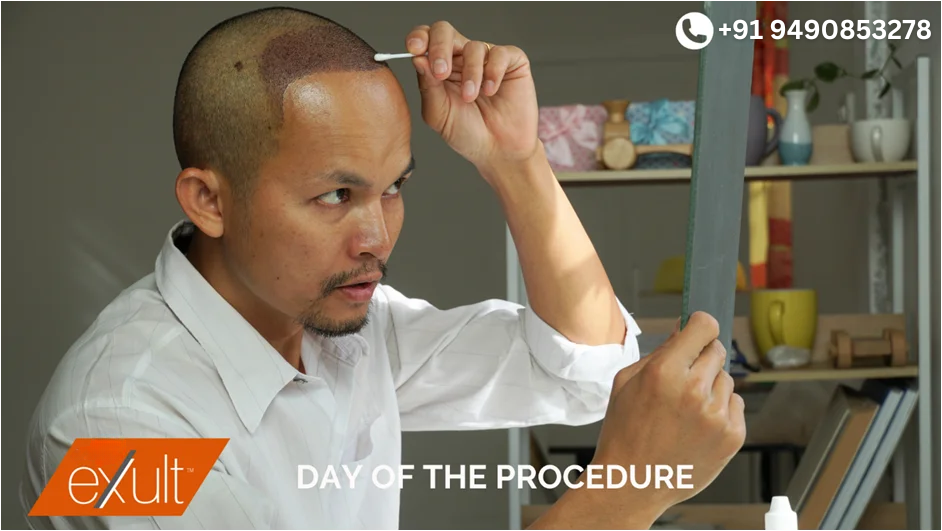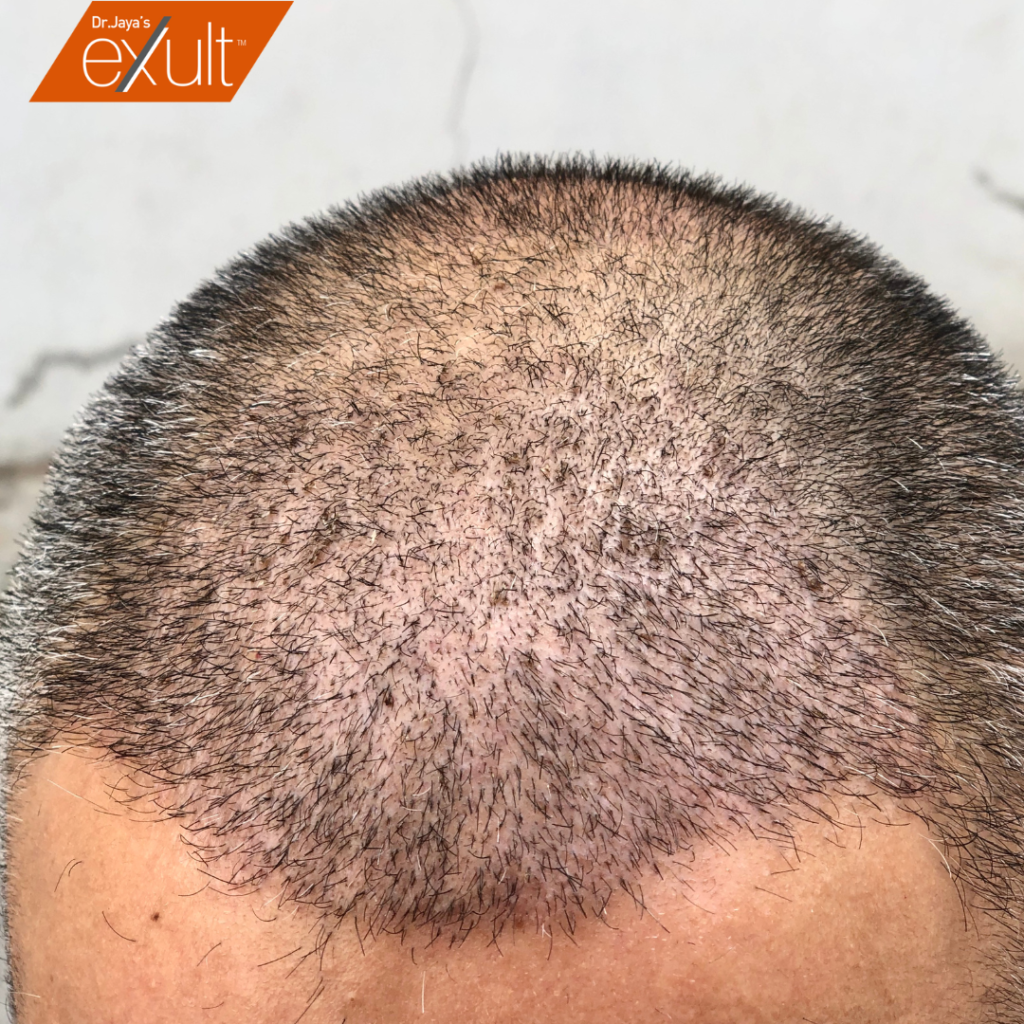Post Hair Transplantation
What are the Post-Operative Instructions for Hair Transplant

DAY OF THE PROCEDURE
Avoid touching the recipient area (the grafted area Keep the transplanted hair grafts moist with saline sprays or drops frequently (for every 2 to 3 hours) Keep a neck pillow or soft pillow with some sheet. Antibiotic analgesics, and normal diet, hydration
Day 1 and Day 2
Day 3
Advised to visit the clinic for the donor dressing change Usually it takes 72 hrs after surgery for epithelisation (healing) and raw areas will be healed by this time. The donor site will be kept
Day 4 and Day 5
Day 6 and Day 7
Day 8 and Day 9
Gentle cleasing of the recipient area with Exultshampoo with the pulp of the finger in a circular motion to remove the scabs. Don’t try to pick the scabs with nails

Day 10, 11, 12, 13, 14
Day 15
Start hair regrowth solution
1ml morning and 1 ml night
Hair vitamins twice daily for 6
months to 1 year
AFTER YOUR PROCEDURE
WOUND CARE
To minimize swelling, apply an ice pack over the eyebrows for 15 minutes every hour, not on the grafts and at least one inch from the hairline if grafts were placed there. You should expect to see small “scabs” at many of the graft sites. These will usually fall off within 7-14 days. Please don’t pick them off; you may disturb the newly planted grafts.
If you have undergone FUE and a dressing is applied, leave it in place until your first follow-up visit on postoperative day 2, at which time it will be removed by our staff.
You may experience the hair in the grafts falling out over the first few weeks after the procedure. This is expected and your new hair will start growing approximately 4-6 months after your procedure.
ACTIVITY
Avoid bending, lifting and straining for 1 week after your procedure. Avoid strenuous activity of any kind for 1 week. Too much activity could cause swelling, bleeding, and loss of grafts. Keep activity VERY minimal. Bend at the knees instead of at the waist when picking up objects and tying shoes.
MEDICATIONS
Antibiotic: Begin when you arrive home after the case, and take as directed until completed.
Pain medication: If prescribed, take this as directed for postoperative discomfort.
FOLLICULITIS
Folliculitis is one or more ingrown hairs that cause pimple-like lesions. Occasionally, a patient may develop this as the new hair is beginning to grow through the surface.
If this happens, apply antibiotic ointment and a warm, moist cloth to the area for several minutes, three times a day. If the area does not improve, please consult our team. Folliculitis will not affect your outcome.
NUMBNESS
Some numbness at the graft sites will most likely occur. This is normal and will begin to resolve in six to eight weeks. Some patients may notice small areas that will remain numb for up to one year.
SPECIAL INSTRUCTIONS
You will need to avoid direct sunlight or cold for three weeks by wearing a hat or other covering that is not knit or tight and will not compress the grafts.
Avoid alcohol for one week after the procedure.
On night 6, apply a generous amount of antibiotic ointment to the newly transplanted graft area and keep it on overnight. This will help to loosen up the scabs before you wash your head on day 7. On day 7, apply a warm compress on the newly transplanted area for 10 minutes to dissolve ointment, and then wash your hair and scalp as usual.
It is normal to bleed slightly overnight. To protect your linens, you will be provided with a disposable towel to use the first evening, and may want to put a towel over your pillow for the first few nights after the procedure.
Call our clinic if you develop any of the following:
Fever (higher than 100 degrees F),
pain not relieved with ordered pain medication,
redness at the incision site,
unexpected swelling (some forehead swelling is not unusual),
heavy bleeding,
foul drainage,
persistent nausea and vomiting,
or any other concerns.
Your post-operative appointments have been scheduled for
Post-operative visit
Day 2 post-op:
Day 7 to 10 post-op :
2-month post-op :
6-month post-op :
9-month post-op :
1-year post-op :
Post-Transplant Hair Care FUE
The day following your surgery is considered post-operative day 1. After your transplant, you may shower your body. Do not let the force of the water hit the grafts or attempt to wash any portion of the hair. Continue to take your antibiotics and other prescriptions as prescribed and remember to wear the cap we provided when outdoors.
Day 2-6
Itching is common during the healing phase. For the donor site ONLY, continue to apply Mupi or Fucilite cream twice per day on days two and three. Beginning on day four, apply coconut oil two to three times per day to the donor site for up to two weeks until scabbing is no longer evident.
You may wash your hair with mild shampoo beginning 72 hours following your procedure. This is an important step to reduce bacteria and lessen the scabbing. Do not let the shower spray directly on the grafts. Wet the scalp, which is most easily accomplished by sitting in the tub or shower and filling a container such as a large measuring cup or pitcher with warm water from the tap. Pour the water so that it hits the non-grafted portion of the scalp, either the front or the back – NOT ON THE GRAFTS. Allow the water to run over the grafts wetting the entire head. Add a small amount of the mild shampoo to the pitcher with some water to make a lather. Pour the lather over the scalp as you did the water to wet the scalp. Leave on for one minute and then rinse with lukewarm water in the same manner by pouring the water on the non-grafted portion of the head and letting the water run over the grafts. Allow the hair to air dry. DO NOT USE A HAIR DRYER. You will repeat this process on days 4, 5 and 6. The night of day 6 you will apply antibiotic ointment to the graft site.
Day 7
On the morning of day 7, it is helpful to gently wipe the ointment off and then apply a warm compress to the grafted area for about ten minutes. You can then step into the shower and treat your head like nothing has happened. You may let the shower spray on the grafts and shampoo normally with mild shampoo and condition with a mild conditioner.
After this, you may blow dry and resume your normal styling routine. Continue to follow this routine for washing and wear a cap when outdoors for a total of two weeks following your surgery.
Beard & Body hair transplant
Beard and body hair is usually harvested with very fine special punches. Heals within 72 hrs.
Advised to apply thin layer of antibiotic ointment ( Mupi / Fucilite )
For 3 days from day 1 post-op after removal of the dressing.
From Day 6 post op Moisturizer can be applied twice daily for another 2 weeks.
Things to Remember After Your Hair Transplant
Follow instructions carefully to avoid loss of grafts.
What to Expect at:






In some cases, your hair might actually look a little thinner after the transplant. This is most likely to occur when pre-existent hairs are present in the transplanted zone. These hairs may thin out in the three months after transplantation, but will usually grow back at about the same time and rate that the new grafts grow in. Do not worry if your hair looks thinner at 3 months after transplantation, your rewards come in 6-12 months.
You will not get the maximum benefit from your transplant until 9-12 months after the procedure, because the hair must have this amount of time to re-grow length and thickness of the shaft. You will see improvement at 4- 6 months in the form of fine short hair, but results peak at 9-12 months.
Hair loss is a relentlessly progressive process; therefore, you may want additional replacement procedures in the future to thicken or cover new areas of loss.
We are always available to discuss any questions or concerns you may have. Please don’t hesitate to call. We always strive to give the best to all our clients.
When Can I Resume….
Light exercise (walking, etc.) Day 1
Use of aspirin products Day 3
Very gentle shampooing of grafts Day 3
Return to brushing of non-grafted hair as usual Day 3
You may style and cut your hair once scabs have healed and sutures dissolved
7 to 14 days
Vigorous shampooing of grafts Day 7
Use of hairdryer Day 7
Use of mousse, gels and hairspray Day 7
Gentle brushing of grafts Day 7
Chemical hair treatments (coloring and perms)
4 weeks
Intense exercise (running, aerobics, etc.) Day 7
Swimming and other water sports
1 to 3 weeks (Up to the neck only until scabs are gone)
Use of hot rollers and curling irons Day 7
Use of Finasteride Day 7
Use of Minoxidil solution 4weeks (When scabs are all gone and redness subsided)
Avoid direct sunlight or cold for 3 weeks
Laser caps and combs 3-4 weeks
LED Vibrating Derma Roller system 6 months
Hairit or other hair fibers 3 weeks
Contact details
CALL 7095678678 10AM TO 8PM ALL WORKING DAYS
CALL 9398268316 ( OFF-CLINIC TIMINGS )
IF IN CASE OF ANY EMERGENCY PLEASE ATTEND
KIMS Hospital Seethammadhara Contact 8712017230 Emergency Department
